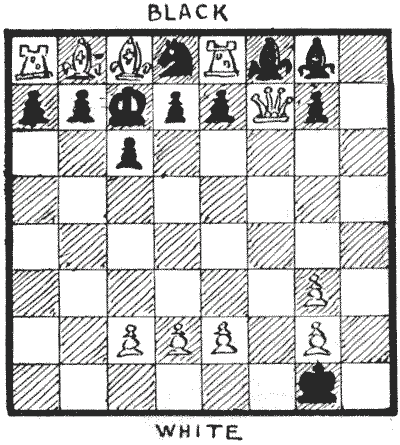One Christmas Eve I was traveling by rail to a little place in one of the southern counties. The compartment was very full, and the passengers were wedged in very tightly. My neighbor in one of the corner seats was closely studying a position set up on one of those little folding chessboards that can be carried conveniently in the pocket, and I could scarcely avoid looking at it myself. Here is the position:—

My fellow-passenger suddenly turned his head and caught the look of bewilderment on my face.
"Do you play chess?" he asked.
"Yes, a little. What is that? A problem?"
"Problem? No; a game."
"Impossible!" I exclaimed rather rudely. "The position is a perfect monstrosity!"
He took from his pocket a postcard and handed it to me. It bore an address at one side and on the other the words "43. K to Kt 8."
"It is a correspondence game." he exclaimed. "That is my friend's last move, and I am considering my reply."
"But you really must excuse me; the position seems utterly impossible. How on earth, for example—"
"Ah!" he broke in smilingly. "I see; you are a beginner; you play to win."
"Of course you wouldn't play to lose or draw!"
He laughed aloud.
"You have much to learn. My friend and myself do not play for results of that antiquated kind. We seek in chess the wonderful, the whimsical, the weird. Did you ever see a position like that?"
I inwardly congratulated myself that I never had.
"That position, sir, materializes the sinuous evolvements and syncretic, synthetic, and synchronous concatenations of two cerebral individualities. It is the product of an amphoteric and intercalatory interchange of—"
"Have you seen the evening paper, sir?" interrupted the man opposite, holding out a newspaper. I noticed on the margin beside his thumb some pencilled writing. Thanking him, I took the paper and read—"Insane, but quite harmless. He is in my charge."
After that I let the poor fellow run on in his wild way until both got out at the next station.
But that queer position became fixed indelibly in my mind, with Black's last move 43. K to Kt 8; and a short time afterwards I found it actually possible to arrive at such a position in forty-three moves. Can the reader construct such a sequence? How did White get his rooks and king's bishop into their present positions, considering Black can never have moved his king's bishop? No odds were given, and every move was perfectly legitimate.
Solutions: 1
This eBook is for the use of anyone anywhere in the United States and most other parts of the world at no cost and with almost no restrictions whatsoever. You may copy it, give it away or re-use it under the terms of the Project Gutenberg License included with this edition or online at http://www.gutenberg.org. If you are not located in the United States, you'll have to check the laws of the country where you are located before using this ebook.